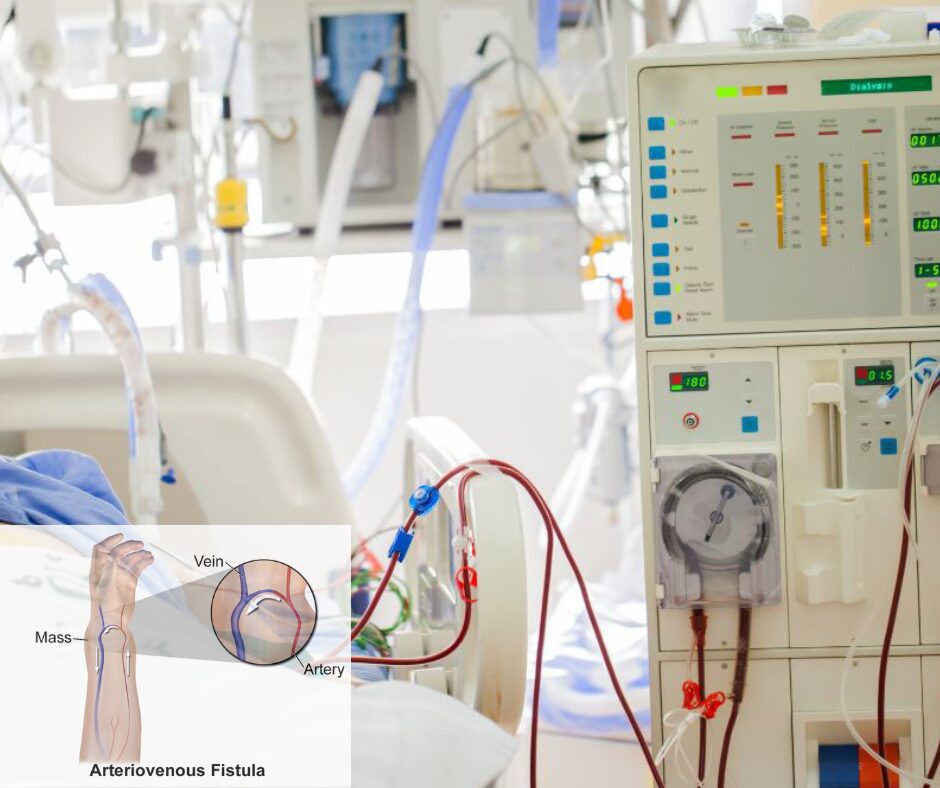What is Fistula Dialysis?
Fistula dialysis refers to the use of an arteriovenous (AV) fistula — a connection between an artery and a vein — for hemodialysis treatment. This connection allows easy and repeated access to your bloodstream, making it the most preferred vascular access for chronic kidney disease (CKD) patients who require long-term dialysis.
AV fistulas are often considered the gold standard because they last longer and have fewer complications compared to other access types, like catheters or grafts.
How is a Fistula Created?
The creation of a fistula is a minor surgical procedure. A vascular surgeon connects a vein and an artery, usually in your forearm or upper arm. After surgery, it takes about 6 to 12 weeks for the fistula to “mature,” meaning the vein becomes stronger and larger, making it ready for dialysis needles.
Key steps in creating a fistula:
- Pre-surgery vein mapping via ultrasound
- Surgical connection of artery and vein
- Healing and maturing process
- Regular monitoring by healthcare providers
Why Fistula is the Best Access for Dialysis?
1. Lower Risk of Infection:
Compared to catheters and grafts, fistulas have the lowest risk of infection because they are made using your own blood vessels.
2. Better Blood Flow:
Fistulas allow for high blood flow, which improves the effectiveness of dialysis sessions.
3. Longer Lasting:
An AV fistula can last for many years with proper care, reducing the need for frequent surgeries or replacements.
4. Fewer Hospitalizations:
Patients with a functioning fistula often experience fewer dialysis-related complications.
How to Care for Your Fistula ?
Proper care of your fistula is critical to ensure it works well for a long time. Here are some essential tips:
- Check your fistula daily for a vibration or “thrill” — it indicates blood is flowing properly.
- Keep the site clean and dry.
- Avoid heavy lifting or putting pressure on your fistula arm.
- Do not allow blood pressure readings, IV lines, or blood draws on your fistula arm.
- Follow your healthcare provider’s instructions regarding exercise to strengthen the fistula.
Common Problems and Warning Signs of Fistula
Although fistulas are generally reliable, problems can still occur. Be alert for:
- Swelling, redness, or warmth around the site
- Decrease or absence of thrill
- Bleeding or bruising
- Pain or discomfort during dialysis
If you notice any of these signs, contact your dialysis center or doctor immediately.
Protect Your Lifeline
An AV fistula is often called a “lifeline” for dialysis patients — and for good reason. It enables life-saving treatment, improves dialysis outcomes, and enhances quality of life. With proper care and attention, your fistula can serve you well for many years.
If you’re considering dialysis or have been recently diagnosed with CKD, talk to your nephrologist about planning for a fistula early. Preparing in advance leads to better results and fewer complications.
FAQ Section for “Fistula Dialysis”
1. What is the main advantage of a fistula for dialysis?
An AV fistula provides better blood flow, lasts longer, and has a much lower risk of infection compared to catheters or synthetic grafts. It is considered the best choice for long-term dialysis.
2. How long does a fistula last?
With proper care, an AV fistula can last several years, sometimes even decades. Regular monitoring and good hygiene are crucial for its longevity.
3. How do I know if my fistula is working?
You should feel a thrill — a buzzing or vibrating sensation — when you touch your fistula. If the thrill disappears or weakens, contact your dialysis center immediately.
4. What happens if my fistula fails?
If a fistula stops working, your doctor may attempt to restore it using procedures like angioplasty. If not possible, they may create a new fistula or use another form of access like a graft or catheter.
5. Can I exercise with a fistula?
Yes, but with caution. Gentle exercises like squeezing a soft ball can help strengthen the fistula after surgery. Avoid lifting heavy weights or putting pressure on the fistula arm.

